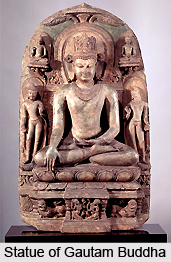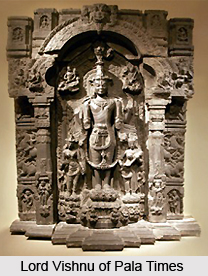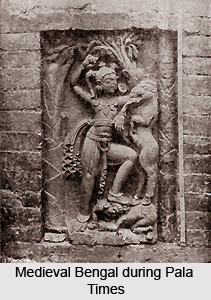 Sculpture witnessed amazing development in the hands of the Palas. Thousands of sculptures belonging to this period have been discovered. In Paharpur around 63 stone sculptures were found at the basement wall of the Somapura Mahavihara. The main feature of Pala sculptures is their free flowing movement. Almost all the figures are of similar sizes and were carved out of grayish or white spotted sandstone. Some of the familiar scenes that have been portrayed on the reliefs are Lord Krishna uprooting the Arjuna trees, image of a young woman and others.
Sculpture witnessed amazing development in the hands of the Palas. Thousands of sculptures belonging to this period have been discovered. In Paharpur around 63 stone sculptures were found at the basement wall of the Somapura Mahavihara. The main feature of Pala sculptures is their free flowing movement. Almost all the figures are of similar sizes and were carved out of grayish or white spotted sandstone. Some of the familiar scenes that have been portrayed on the reliefs are Lord Krishna uprooting the Arjuna trees, image of a young woman and others.
Terracotta is a key feature of Pala sculpture. However Pala sculpture was not limited to it. Significant developments were noticed in the fields of architecture, terracotta, sculpture and painting. From the few evidences found it can be deduced that most of the monuments built during the Pala reign were Buddhists. But most of the remains are found at Paharpur including the famous terracotta plaques that are enough to reveal their architectural wizardry. Similar features of Pala sculpture are also to be found in countries like Myanmar and Indonesia. Some of the Buddhist buildings here have been inspired from the Paharpur style of architectures.
As far as the terracotta plaques are concerned these have been primarily used to decorate the surface of the walls. It is believed that these are unique creations by the Bengal sculptors and still stands as one of the key features of the Pala sculpture. Besides the religious themes several images representing daily life are also to be found on these plates or  plaques. Apart from the religious aspect these sculptural plaques also act as evidence of the social history. Artistic specimens from this age are to be found all over Bengal and Bihar. Besides Bengal other Pala sculptures have been discovered at Nalanda, Kurkihar, Bodh Gaya, and Magadha. Some of the important monuments belonging to this age are the Somapura Vihara and Vikramasila Vihara.
plaques. Apart from the religious aspect these sculptural plaques also act as evidence of the social history. Artistic specimens from this age are to be found all over Bengal and Bihar. Besides Bengal other Pala sculptures have been discovered at Nalanda, Kurkihar, Bodh Gaya, and Magadha. Some of the important monuments belonging to this age are the Somapura Vihara and Vikramasila Vihara.
The features of Pala sculptures were developed from the late Gupta period style. However at a later stage the Pala style drifted away from its origin and developed its own style, known as the Pala School of Sculptural Art. One of the major reasons for this deviation was the fusion of the classical style with the native Bengali style of architecture. This amalgamated style of architecture began in the middle of the 7th century continued through the 8th century. It was in the 9th century that a separate school came into being. Inspite of being religious sculptures these images reflected grace and beauty. Sensuousness then became a predominant feature of the female and male figures. While the female figures are noted for their thick lips and rounded figures, the male figures sport broad shoulders and narrow waists. Such features of the male sculptures emphasize their masculinity.
Another striking Pala sculpture is the image of Hari-Hara from Burdwan. Apart from this several sculptures have been discovered from the northern region of Bangladesh. These sculptures date back to the 8th century. Amongst these the Garudasana Vishnu from Agradigun is truly well carved. Fullness of figure is one of the features of the Pala sculptures from the 8th centuries. These carved out images are mostly made of black stone with soft textures. The 9th century Pala sculptures show similar characteristics. Some of the finest examples are the image of Surya on the Bodh Gaya lintel, a miniature Lord Vishnu and an image of Gautama Buddha taming an elephant. The stone image of Tara, Surya and Vishnu from Dhaka (Bangladesh) also reflect the prominent features of Pala sculptures. These specimens have been placed in the museums.
 The important Pala sculptures that have been discovered from Bengal and Bihar include the carved figures of Vagishvari, Saugati-Sandarshana Lokeshvara, Avalokiteshvara and three images Ganesha. A number of 10th century stone sculptures from Bangladesh include the figures of Rishabhanatha from Dinajpur, Garuda from Rajshahi, Varaha, Manasa, Durga, Indrani and Bhrukuti Tara. The male figures of the 10th century Pala sculptures are depicted as sturdy and dynamic with elongated body forms. These features are evident from the bronze image of Buddha from Paharpur monastery.
The important Pala sculptures that have been discovered from Bengal and Bihar include the carved figures of Vagishvari, Saugati-Sandarshana Lokeshvara, Avalokiteshvara and three images Ganesha. A number of 10th century stone sculptures from Bangladesh include the figures of Rishabhanatha from Dinajpur, Garuda from Rajshahi, Varaha, Manasa, Durga, Indrani and Bhrukuti Tara. The male figures of the 10th century Pala sculptures are depicted as sturdy and dynamic with elongated body forms. These features are evident from the bronze image of Buddha from Paharpur monastery.
It is at the end of the 10th century that changes take place in Pala art and architecture under the reign of Mahipala I. It is during this time that Bengali artists build a separate identity for their art that completely broke away from the Magadha style. The finest sculptures during this era were produced by the artists from North Bengal. Most of the Buddhist sculptures from this era were female. These sculptures were predominantly Buddhist and they included Tantric Buddhist images of Heruka, Marichi and Manjuvara. As a prototype of new Bodhisattva the black stone image of Sadaksari Lokeshvara is outstanding.
The most interesting Pala sculpture from 11th century is a black stone image of Bodhisattva Manjushri. The sculptures here are intricately carved. Figures representing Hindu gods and goddesses are also found from the Pala dynasty. Another notable piece of art from this era is the six-handed stone figure of Lord Ganesha. Bronze sculptures have also been discovered belonging to the Pala kingdom. Several Pala sculptures of Buddhist gods and goddesses from 12th century have been discovered in Bangladesh.
The features of the early Pala sculptures differed greatly from the latter ones. This style began as an untainted reflection of religion on stone. As a result the earliest Pala sculptures have less ornament and are easily moveable. But the later 10th sculptures are heavily bejeweled and the background of the images are intricately designed. In the 11th century more changes seeped in when more stress was given to vegetal decoration of the back slab, the main deities were adorned with jewelries and the artists paid heed to the most trifle details. Elongated bodies, expressive chiseled faces and the pointed stele was overdone with a number of figures and elaborate designs.



